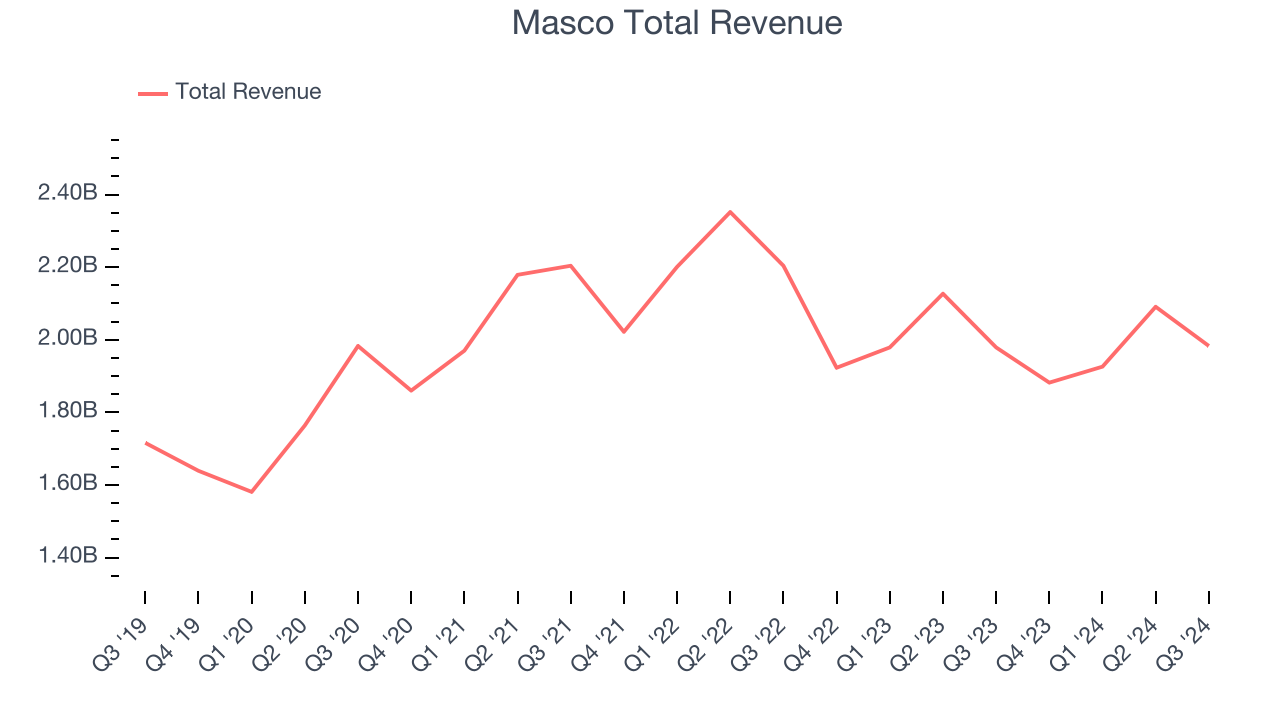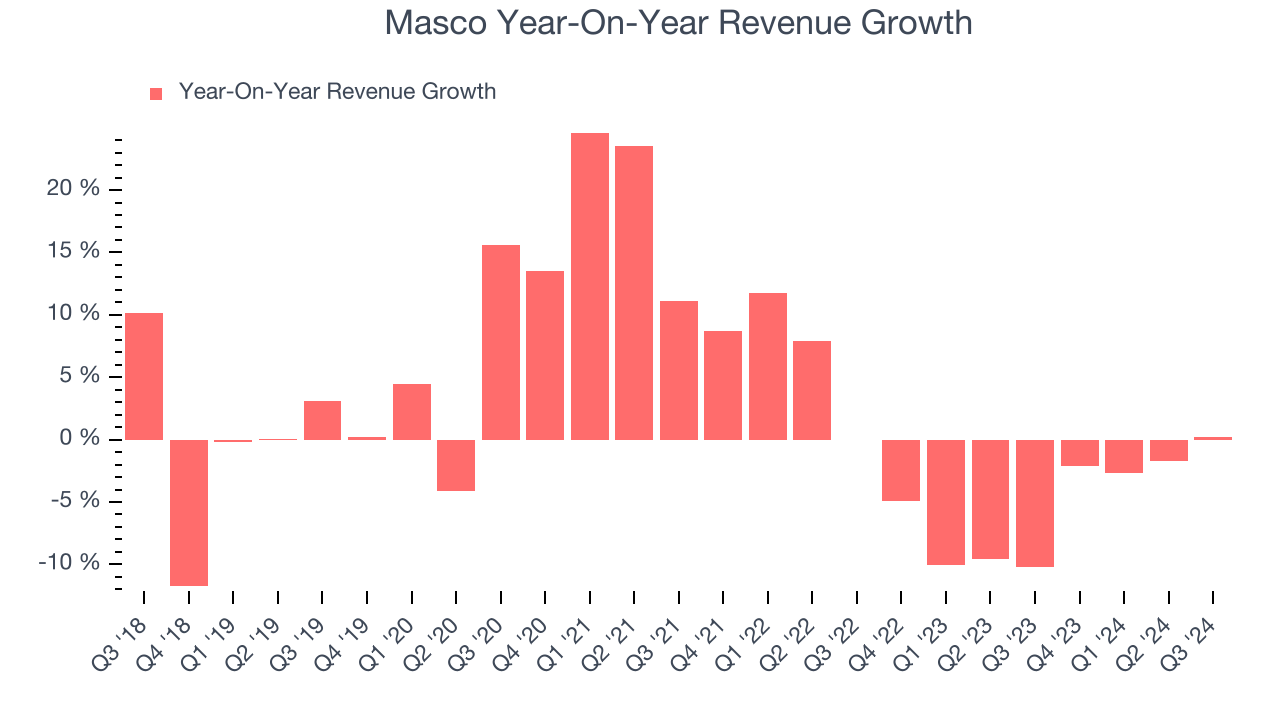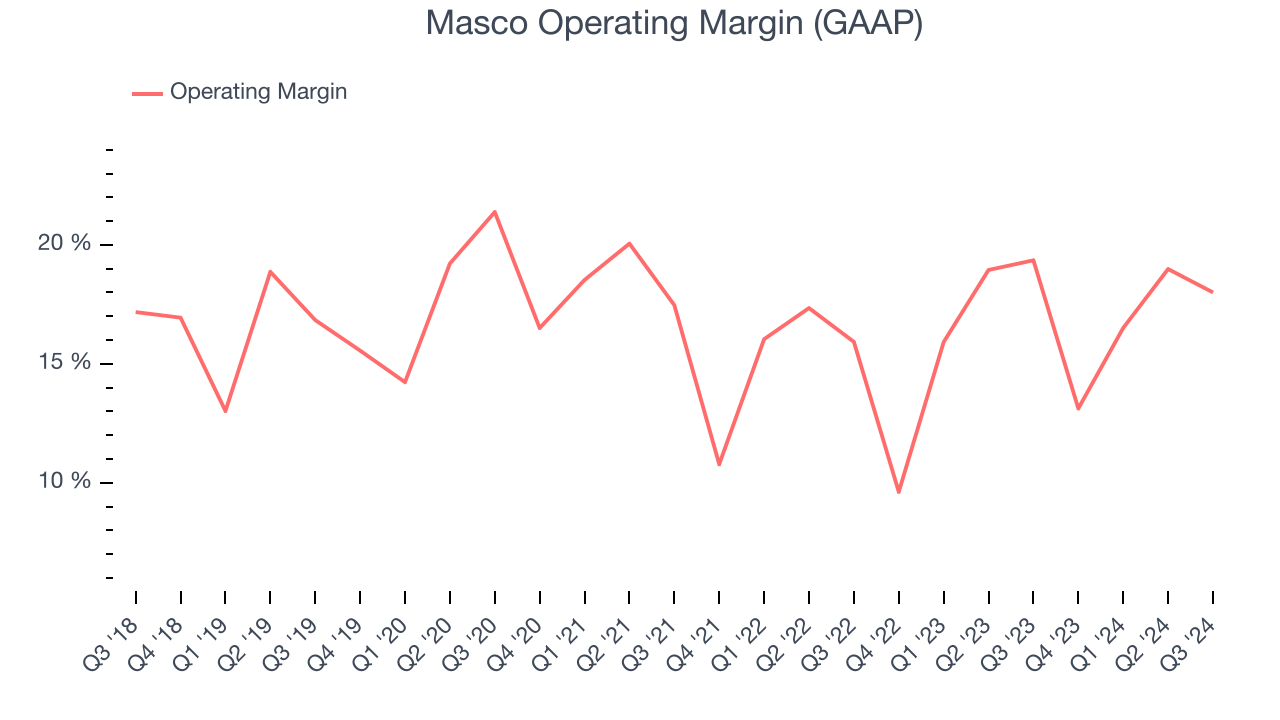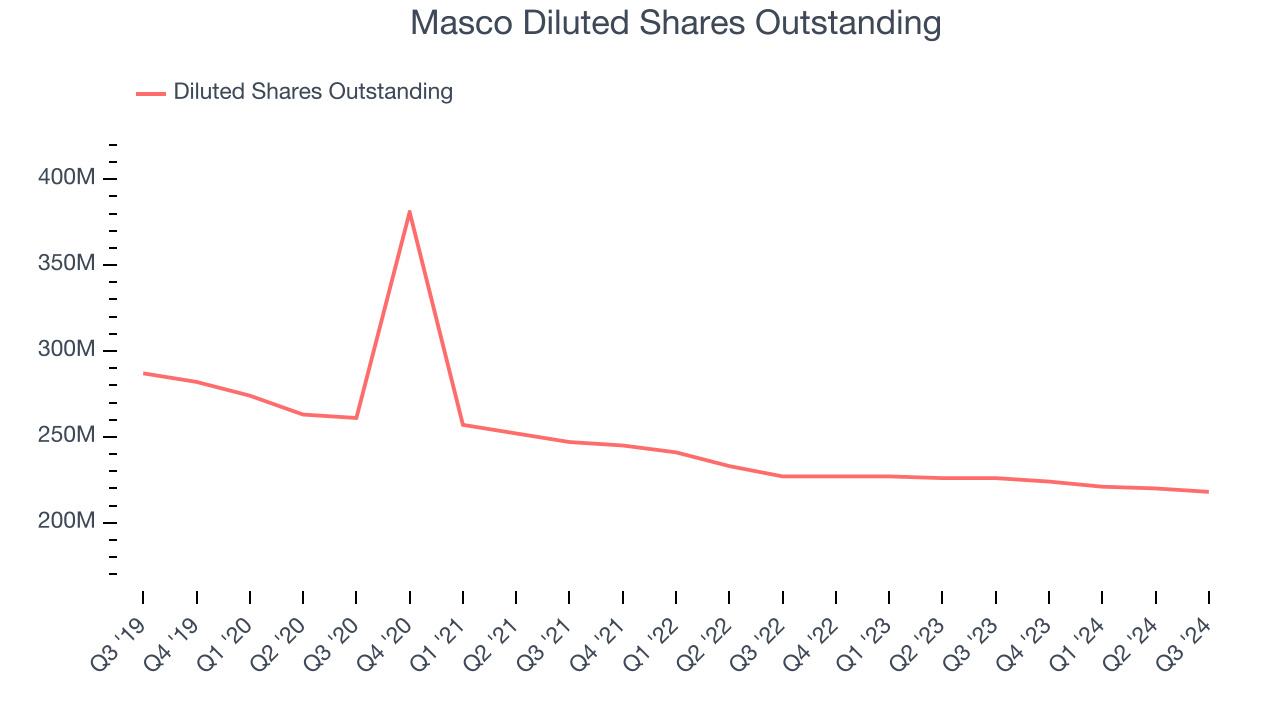Home-building design and manufacturing company Masco Corporation (NYSE:MAS) met Wall Street’s revenue expectations in Q3 CY2024, but sales were flat year on year at $1.98 billion. Its non-GAAP profit of $1.08 per share wasalso in line with analysts’ consensus estimates.
Is now the time to buy Masco? Find out by accessing our full research report, it’s free.
Masco (MAS) Q3 CY2024 Highlights:
- Revenue: $1.98 billion vs analyst estimates of $2.00 billion (in line)
- Adjusted EPS: $1.08 vs analyst expectations of $1.09 (in line)
- EBITDA: $397 million vs analyst estimates of $397.1 million (small miss)
- Management lowered its full-year Adjusted EPS guidance to $4.10 at the midpoint, a 0.6% decrease
- Gross Margin (GAAP): 36.6%, down from 37.6% in the same quarter last year
- Operating Margin: 18%, down from 19.4% in the same quarter last year
- EBITDA Margin: 20%, in line with the same quarter last year
- Free Cash Flow Margin: 19.1%, down from 21.8% in the same quarter last year
- Market Capitalization: $17.83 billion
“We delivered another quarter of strong operating results,” said Masco President and CEO, Keith Allman.
Company Overview
Headquartered just outside of Detroit, MI, Masco (NYSE:MAS) designs and manufactures home-building products such as glass shower doors, decorative lighting, bathtubs, and faucets.
Home Construction Materials
Traditionally, home construction materials companies have built economic moats with expertise in specialized areas, brand recognition, and strong relationships with contractors. More recently, advances to address labor availability and job site productivity have spurred innovation that is driving incremental demand. However, these companies are at the whim of residential construction volumes, which tend to be cyclical and can be impacted heavily by economic factors such as interest rates. Additionally, the costs of raw materials can be driven by a myriad of worldwide factors and greatly influence the profitability of home construction materials companies.
Sales Growth
A company’s long-term performance can give signals about its business quality. Even a bad business can shine for one or two quarters, but a top-tier one grows for years. Over the last five years, Masco grew its sales at a sluggish 3.3% compounded annual growth rate. This shows it failed to expand in any major way, a rough starting point for our analysis.

Long-term growth is the most important, but within industrials, a half-decade historical view may miss new industry trends or demand cycles. Masco’s history shows it grew in the past but relinquished its gains over the last two years, as its revenue fell by 5.2% annually. 
This quarter, Masco’s $1.98 billion of revenue was flat year on year and in line with Wall Street’s estimates.
Looking ahead, sell-side analysts expect revenue to grow 2.2% over the next 12 months. Although this projection illustrates the market thinks its newer products and services will spur better performance, it is still below the sector average.
Today’s young investors won’t have read the timeless lessons in Gorilla Game: Picking Winners In High Technology because it was written more than 20 years ago when Microsoft and Apple were first establishing their supremacy. But if we apply the same principles, then enterprise software stocks leveraging their own generative AI capabilities may well be the Gorillas of the future. So, in that spirit, we are excited to present our Special Free Report on a profitable, fast-growing enterprise software stock that is already riding the automation wave and looking to catch the generative AI next.
Operating Margin
Masco has been a well-oiled machine over the last five years. It demonstrated elite profitability for an industrials business, boasting an average operating margin of 16.7%. This result isn’t too surprising as its gross margin gives it a favorable starting point.
Looking at the trend in its profitability, Masco’s annual operating margin decreased by 1.1 percentage points over the last five years. Even though its margin is still high, shareholders will want to see Masco become more profitable in the future.

This quarter, Masco generated an operating profit margin of 18%, down 1.4 percentage points year on year. Since Masco’s operating margin decreased more than its gross margin, we can assume it was recently less efficient because expenses such as marketing, R&D, and administrative overhead increased.
Earnings Per Share
We track the long-term change in earnings per share (EPS) for the same reason as long-term revenue growth. Compared to revenue, however, EPS highlights whether a company’s growth was profitable.
Masco’s EPS grew at a remarkable 12.9% compounded annual growth rate over the last five years, higher than its 3.3% annualized revenue growth. However, this alone doesn’t tell us much about its day-to-day operations because its operating margin didn’t expand.

We can take a deeper look into Masco’s earnings to better understand the drivers of its performance. A five-year view shows that Masco has repurchased its stock, shrinking its share count by 24%. This tells us its EPS outperformed its revenue not because of increased operational efficiency but financial engineering, as buybacks boost per share earnings. 
Like with revenue, we analyze EPS over a shorter period to see if we are missing a change in the business.
For Masco, its two-year annual EPS growth of 3.4% was lower than its five-year trend. We hope its growth can accelerate in the future.In Q3, Masco reported EPS at $1.08, up from $1 in the same quarter last year. This print was close to analysts’ estimates. Over the next 12 months, Wall Street expects Masco’s full-year EPS of $4.04 to grow by 8.9%.
Key Takeaways from Masco’s Q3 Results
We struggled to find many strong positives in these results. Its revenue unfortunately missed and its EPS fell short of Wall Street’s estimates. Overall, this was a weaker quarter. The stock traded down 1.7% to $80.25 immediately after reporting.
Masco may have had a tough quarter, but does that actually create an opportunity to invest right now?What happened in the latest quarter matters, but not as much as longer-term business quality and valuation, when deciding whether to invest in this stock. We cover that in our actionable full research report which you can read here, it’s free.
